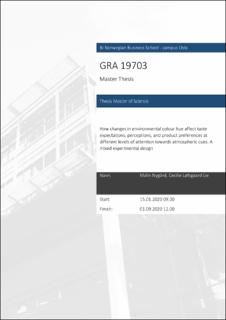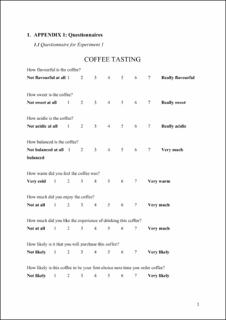| dc.description.abstract | How does changes in environmental colour hue affect taste expectations,
perceptions, and product preferences at different levels of attention toward
atmospheric cues? Previous research has showed that environmental colour hue
can influence taste experiences, however, the mechanisms behind this are not
fully understood. In the present study, we aimed to study the effects of
environmental colour hue hue on people’s taste expectations, perceptions, and
product experiences. In addition, we evaluated attention as a potential mechanism
for such crossmodal effects. In Experiment 1, we studied coffee perceptions by
using virtual reality, considering that this is an increasingly attractive technology
for marketers interested in immersive experiences. In Experiment 2, we studied
coffee expectations by using another increasingly used visualization mode,
namely 360-degree environments. In both studies, we followed a 2 (higher
attention vs. lower attention) x 3 (red vs. green. vs. white) mixed between-within
experimental design for both experiments, with the first factor being between
participants and the second within participants. We evaluated how these factors
would influence the sensory, hedonic, and market related aspects of the coffee
tasting experience.
The results of Experiment 1 suggested that environmental colour hue made the
coffee seem more flavourful in the white atmosphere compared to the red
atmosphere. There was also evidence of higher attention leading to higher
flavourful and sweetness scores, as well as a greater immersion experience.
Higher attention also made the coffee seem more balanced in the green
atmosphere relative to the white and red atmospheres. The group that was
instructed to pay attention to the atmospheres enjoyed the taste and liked the drink
experience more in the green atmosphere compared to the red atmosphere. While
the group that got no such instructions liked the drink experience more in the
white atmosphere compared to the green atmosphere. In Experiment 2, the results
showed that environmental colour hue affected how warm the coffee was
expected to be and the expected drink experience likeability. The white 360-
degree environment generated higher drink experience likeability and expected
temperature of the coffee. The findings contribute to the managerial understanding
of the role of environmental colour hue in the customer experience journey and
also to the multisensory experience literature.
Keywords: Coffee, colour, crossmodality, expectation, perception, flavour, light, multisensory,
taste, virtual reality, virtual environment, attention, experience, experiment | en_US |

